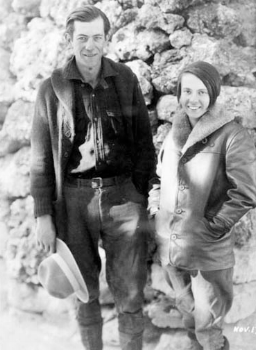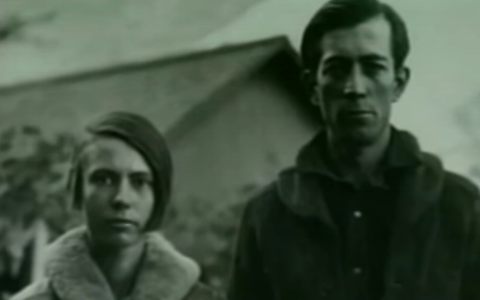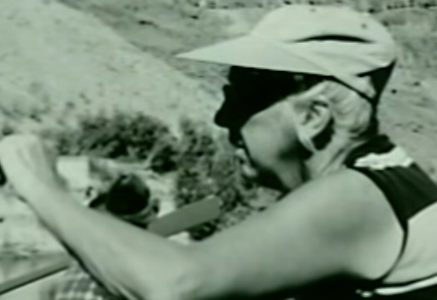The strange disappearance of Glen and Bessie Hyde from the Grand Canyon National Park
Glen and Bessie Hyde, last seen, November 18, 1928, (Last Diary Entry November 30, 1928), Colorado River, Grand Canyon National Park, Arizona.
Revised December 2024
A newly married couple, Glen and Bessie Hyde, set off on a honeymoon trip on the Green and Colorado Rivers in October 1928.
In those days, the Grand Canyon had no commercial river trips, and the rapids were only for seasoned explorers and professional expeditions. Safety was also a lower priority than today - they wore no life jackets or specialist wet weather gear. Certainly not a trip for a pair of honeymooners in a homemade scow (a type of barge) called “Rain in the Face”. Early in the trip, Glen fell out of the boat on a rapid, confirming the dangers.
The couple was last seen on November 18, 1928, and their scow was found in early December, around three weeks later. It was found floating upright around River Mile 237 and filled with belongings, and the supplies were fully strapped in. But Glen and Bessie were nowhere to be seen. A huge search revealed no trace of the couple. They had vanished somewhere in the Grand Canyon.
Who were Glen and Bessie Hyde?
The Hydes met on a passenger ship traveling to Los Angeles in 1927. They were married on April 12, 1928.
Glen was an expert boat builder who built the 20-foot-long wooden sweep scow and had rafting experience on the Salmon and Snake Rivers in Idaho a couple of years earlier. In contrast, Bessie was a novice to rivers and rapids. Glen was determined to set a new speed record for the trip through the Grand Canyon, and he wanted Bessie to make history as the first documented woman to run the canyon.
Bessie Hyde, 22, was an aspiring artist and could be described as bohemian. According to the late Otis "Dock" Marston's library, the couple planned to run the canyon, then go on the lecture circuit and make money retelling their adventure.
The Colorado and Green Rivers journey
Starting on October 20, 1928, the Hydes’ started their adventure in the city of Green River in Utah and made a successful run through many major rapids of the Green and Colorado Rivers. They estimated it would take them no more than a month and a half to complete their journey. Almost a month into the trip, they spent a few days restocking at Grand Canyon Village on the South Rim on November 16th. At this time, they talked with a reporter from the Denver Post, assuming that their final destination, Needles, in California, was just a few weeks away.
They hiked along the Bright Angel Trail, where they met brothers Ellsworth and Emery Kolb, famous photographers who ran a cliffside studio. Glen and Bessie went to the studio and introduced themselves to the Kolbs, explaining that they were honeymooners who had been rafting on the river for 26 days. The Kolb brothers said that the couple asked to have their photo taken on the canyon rim, and they would return to retrieve it after the trip was completed.
Emery Kolb
According to Emery Kolb, Glen said they did not have life preservers, which evoked a warning from Kolb that Glen responded to with a laugh. Kolb offered the couple life preservers, but they refused, saying they could swim anything. Emery also said that Bessie looked nervous about the remaining journey ahead.
As Glen and Bessie prepared to depart and walk down the trail to their boat, Emery Kolb’s daughter Emily appeared nicely dressed. Bessie remarked, “I wonder if I shall ever wear pretty shoes again.” People who encountered the couple during their layover later claimed that Bessie wanted to leave the trip.
Bessie and Glen
It is said that a man named Adolph G. Sutro accompanied the couple back into the canyon, taking photographs and even riding a short distance with them in the boat. Sutro was likely the last person to see the Hydes alive if this is true.
The disappearance and search for the Hydes
By early December, Glen and Bessie had not been heard from. As a result, Emory Kolb initiated a search of the area, including a small plane that flew through the inner gorge of the canyon. On December 20, 1928, the pilot saw the intact Hydes’ scow caught in the rocks on the river 15 miles south of Diamond Creek. The assumption was that somewhere in the canyon, they were on a ledge waiting to be found after 21 days.
When the rescue party reached the boat, they found food, clothing, books, Bessie’s journal, and a camera, which revealed the final photo to have been shot near river mile 165 on or about November 27. The last entry in Bessie's journal was written on November 30th near Diamond Creek.
Reith Hyde
Glen’s father, Reith Hyde, aged 70, hired a group of men to search the canyon within the area where Glen and Bessie likely traveled near Diamond Creek. He even enlisted Ellsworth and Emery Kolb to help. But after 41 days of searching, they had no success. Not a trace.
What happened to the Hydes?
Since the couple's disappearance, plenty of mysterious stories about their fate have existed. What happened out there on the river?
The obvious answer was that they both died in the rapids, but why was the boat found intact and upright?
Perhaps Glen Hyde was a bully who forced Bessie to continue the journey when she didn't want to and perhaps even killed her in a fit of frustrated rage. Alternatively, perhaps Bessie killed Glen and disappeared.
Some friends of Georgie Clark, a woman who gained fame for her rafting adventures in the Grand Canyon, speculate that she was Bessie Hyde. A potential link between Georgie and Bessie started when friends looked through her personal items following her death in 1992. People who had known her for decades had never been invited into her home. Upon looking at Clark’s personal effects, her friends learned that her birth certificate indicated that her real name was Bessie DeRoss, not Georgie.
Her friends’ curiosity was raised when they found the marriage license of Glen and Bessie Hyde at her home and a pistol in her lingerie drawer. Colorado River historian Brad Dimock – whose book, “Sunk Without a Sound – The Tragic Colorado River Honeymoon of Glen and Bessie Hyde,” investigates the couple’s story and the subsequent theories examined the items from Clark’s home and concluded from photographs that Clark and Bessie Hyde were not the same people. The two women didn't even resemble each other, and it's more likely that the items were souvenirs.
Liz Cuttler
On a 1971 commercial boat trip, an elderly woman called Liz Cuttler announced over the evening campfire that she was Bessie Hyde. "What did you do with Glen?" a boatman called George Billingsley asked, half-joking." I killed him," the woman answered without looking up. The honeymooners fought, she added; she stabbed Glen and hiked out to Peach Springs, Arizona, then caught a bus back East to start a new life. Further investigations failed to prove a link between the woman and the disappearances, and she was identified as a psychology professor from Ohio who liked to play mind games.
In 1976, a male skeleton was found hidden in his garage on Emery Kolb's property. It was believed to be Glen's, but analysis of the bones showed it was too young to have been him. Due to the high muscle mass exhibited by the remains, it was determined that it was a manual laborer. The skull's features did not match Glen's.
To this day, the disappearance of Glen and Bessie Hyde on the Colorado River remains a mystery, but they were likely lost in the area of Mile 232, 45 miles from the end of the Grand Canyon.
Exclusive articles for members of StrangeOutdoors that are not available elsewhere on the site.
Read more Strange Stories from Arizona
The strange disappearance and death of Janet Castrejon in the Chiricahua Mountains
The strange disappearance of Ranger Paul Fugate from Arizona’s Chiricahua Monument
The shocking disappearance of GPS Joe (Joe Domin) in the Mazatzal Mt. Wilderness
The strange disappearance of Mary Sloan from Mount Graham
The bizarre disappearance of Morgan Heimer from Grand Canyon National Park
The strange disappearance of Drake Cramer in the Grand Canyon National Park
The strange disappearance of Floyd Roberts in the Grand Canyon National Park (Member only)
The agonizing disappearance of Khayman Welch in Tonto National Forest
The shocking disappearance of David Barclay Miller
The tragic Carol Turner disappearance in the Organ Pipe Cactus National Monument
Sources
https://en.wikipedia.org/wiki/Glen_and_Bessie_Hyde
http://articles.latimes.com/2001/jun/29/news/cl-16386
https://explorethecanyon.com/grand-canyon-adventurers-glen-and-bessie-hyde/
Further Reading and viewing
"Sunk Without a Sound: The Tragic Colorado River Honeymoon of Glen and Bessie Hyde" (Fretwater Press), by Brad Dimock
The Grand Canyon Mystery https://www.youtube.com/watch?v=wdbxZNU6wrE






